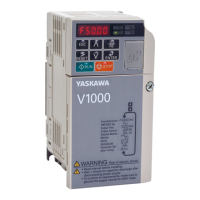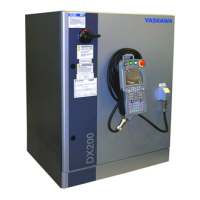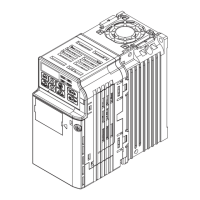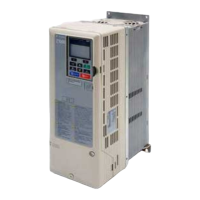5.11 S: Functions for Textile Applications
222 YASKAWA ELECTRIC SIEP C710606 44B YASKAWA AC Drive T1000V Technical Manual
Conditions that Stop KEB
While KEB is being executed, any one of the following conditions will stop the KEB process.
• All the conditions that trigger KEB are no longer present, the minimum time for KEB (S4-13) has passed, and the DC
bus voltage is greater than the level required for KEB to complete (S4-06) for longer than the time set in S4-07.
Note: KEB cannot complete until the time set to S4-07 has passed, even if all other conditions to stop KEB have been met.
• Once power is restored, the input terminal set for KEB 1 (H1- = 65 or 66) that triggered KEB is released.
Note: When an input terminal is programmed to trigger KEB, the operation of KEB depends on the opening and closing of that
terminal.
DC Bus Voltage Control (KEB 1), Power KEB (KEB 3)
Below Figure 5.76 demonstrates how KEB 1 and KEB 3 operate.
The KEB function is triggered when one of the previously explained conditions becomes true. The KEB function starts
by immediately applying a frequency gain in order to bring the motor into a regenerative state, then quickly decelerates
the motor.
The deceleration is performed for at least the time set in parameter S4-13. The drive controls the deceleration so that the
energy needed to keep the DC bus voltage at the level set in S4-11 is fed from the rotating system back into the drive.
KEB 1 (S4-01 = 1) uses the deceleration times set in S5-01 and S5-02 as a base, and adjusts the deceleration rate
depending on the DC bus voltage. KEB 3 (S4-01 = 3) uses motor and machine inertia data only to calculate the optimal
deceleration rate. The deceleration time settings have no effect during KEB 3.
The KEB function ends when one of the previously explained conditions becomes true. At the end of KEB, the drive
holds the output frequency for the time set in parameter S4-12, then accelerates back to the frequency reference. The
acceleration time is defined by parameter S5-05. If S5-05 is set to 0, then the drive uses the acceleration times set in C1-
01, C1-03, C1-05, and C1-07.
Note: Make sure that the Run command remains enabled during power loss. If the Run command is released, then the drive will not be
able to accelerate back up to the frequency reference once power is restored.
Figure 5. 76
Figure 5.76 KEB Function when S4-01 = 1 or 3
Main Power Supply
Power Loss Power Restored
0 V
DC Bus Voltage
0 V
Output Frequency
0 Hz
S4-03 (KEB Start Voltage)
S4-04 (KEB Start dv/dt Level)
S4-10 (KEB 1Phase Loss
Detection Time)
S4-06 (KEB End Voltage)
S4-11 (KEB Target Voltage)
S4-12 (KEB
Hold Time)
S4-07 (KEB End
Detection Time)
S5-07 (Frequency Gain at KEB Start during Constant Speed)
S5-08 (Frequency Gain at KEB Start during Acceleration)
S5-09 (Frequency Gain at KEB Start during Deceleration)
Deceleration using
S5-01 and S5-02, or
Power KEB
S5-05 (KEB 1 Synchronous
Acceleration Time) or
C1-01, C1-03, C1-05, C1-07
(Acceleration Time 1, 2, 3, 4)
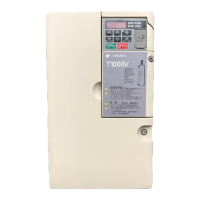
